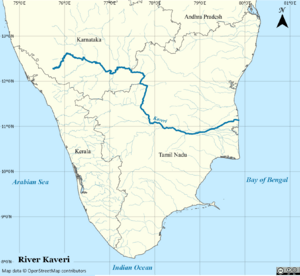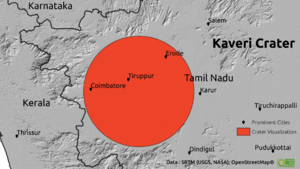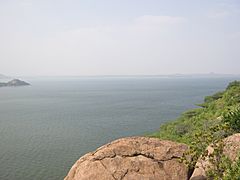Kaveri facts for kids
Quick facts for kids Kaveri |
|
|---|---|

Kaveri River flowing in Srirangapatna
|
|

Map of the Kaveri River basin
|
|
| Other name(s) | Cauvery |
| Country | India |
| States | Karnataka, Tamil Nadu, Kerala, Puducherry |
| Region | Southern India |
| Origin | Kodagu, Karnataka |
| Physical characteristics | |
| Main source | Talakaveri, Kodagu, Western Ghats, Karnataka Karnataka, India 1,341 m (4,400 ft) 12°23′N 75°29′E / 12.383°N 75.483°E |
| River mouth | Bay of Bengal Poompuhar, Tamil Nadu, India 0 m (0 ft) 11°21′40″N 79°49′46″E / 11.36111°N 79.82944°E |
| Length | 805 km (500 mi) |
| Discharge (location 2) |
(Period: 1998-2022)1,151.2 m3/s (40,650 cu ft/s)
|
| Basin features | |
| Basin size | 81,155 km2 (31,334 sq mi) |
| Tributaries | |
The Kaveri (also known as Cauvery, the anglicised name) is one of the major Indian rivers flowing through the states of Karnataka and Tamil Nadu. The Kaveri River rises at Talakaveri in the Brahmagiri range in the Western Ghats, Kodagu district of the state of Karnataka, at an elevation of 1,341 m above mean sea level and flows for about 800 km before its outfall into the Bay of Bengal. It reaches the sea in Poompuhar, in Mayiladuthurai district. It is the third largest river – after Godavari and Krishna – in southern India, and the largest in the state of Tamil Nadu, which, on its course, bisects the state into north and south. In ancient Tamil literature, the river was also called Ponni (the golden mother, in reference to the fine silt it deposits).
The Kaveri is a sacred river to the people of Southern India and is worshipped as the Goddess Kaveriamma (Mother Cauvery). It is considered to be among the seven holy rivers of India. It is extensively used for agriculture in both Karnataka and Tamil Nadu.
The catchment area of the Kaveri basin is estimated to be 81,155 square kilometres (31,334 sq mi) with many tributaries including Harangi, Hemavati, Kabini, Bhavani, Lakshmana Tirtha, Noyyal, and Arkavati. The river basin covers three states and a Union Territory as follows: Tamil Nadu, 43,868 square kilometres (16,938 sq mi); Karnataka, 34,273 square kilometres (13,233 sq mi); Kerala, 2,866 square kilometres (1,107 sq mi); and Puducherry, 148 square kilometres (57 sq mi). In Chamarajanagar district it forms the island of Shivanasamudra, on either side of which are the scenic Shivanasamudra Falls that descend about 100 metres (330 ft). The river is the source for an extensive irrigation system and for hydroelectric power. The river has supported irrigated agriculture for centuries and served as the lifeblood of the ancient kingdoms and modern cities of southern India. Access to the river's waters has pitted Indian states against each other for decades. It was profusely described in the Tamil Sangam literature and is held in great reverence in Hinduism. The Kaveri River delta is a thickly populated delta, one which is frequently affected by tropical cyclones formed in the Bay of Bengal.
Contents
Etymology
Dravidian
- The etymology of the river was derived from the Sankethi word for "river", ಕಾವೇರಿ காவிரி (kāviri), as this is the major river for the Sankethi people that live along its waters. The word is from the Dravidian/Tamil root words "ka" and "viri", "கா" and "விரி", which roughly translates to "branching into fields/forests", due to the river's multiple divergences in the delta region.
Sanskrit
Marudvṛdhā is another hypothesised name for this river, meaning "the beloved of the Maruts". However, this is unlikely as Marudvrdhā is also identified with a river in Punjab.
Epithets
The Kaveri River is also known as Daksina Ganga, the "Ganges of the South" and Kaveri Amman when worshipped as a river goddess. In ancient Tamil literature, the river was also called Ponni (the golden maid, in reference to the fine silt it deposits).
Course
The Kaveri River is a perennial, monsoon rain fed river. It rises at Talakaveri, located in the Kodagu district in the Indian state of Karnataka. After the river leaves the Kodagu hills it flows onto the Deccan plateau and forms two islands, Srirangapatna and Shivanasamudra. At Shivanasamudra, the river drops 91 m (299 ft) and forms the Shivanasamudra Falls, India's second largest waterfall. The falls are made up of two rapids called Gagana Chukki and Bhara Chukki. The river converges after the falls and passes through the Mekedatu gorge.
The river enters Tamil Nadu through the Dharmapuri district and meanders until the Hogenakkal Falls. From there, it flows towards the town of Salem and enters the Stanley Reservoir in Mettur, where the Mettur Dam was constructed in 1934. After passing the reservoir, the Bhavani River, a main right bank tributary, joins with the Kaveri River.
The river then enters the Tiruchirappalli district and eventually splits into two branches, the northern part is called the Kollidam River or Coleroon, and the southern part of the river retains the name "Kaveri". After flowing for 16 km (9.9 mi) the two rivers converge and form the Srirangam Island, and then further branches off into 36 different channels. The river travels 765 km (475 mi) before emptying into the Bay of Bengal.
Discharge
Average, minimum and maximum discharge (m3/s) of the Kaveri River at Grand Anicut and Lower Caleroon Anicut (Lower Anicut). Period from 1998 to 2022.
| Year | Grand Anicut | Lower Anicut | ||||||
|---|---|---|---|---|---|---|---|---|
| (m3/s) | (m3/s) | |||||||
| Min | Mean | Max | Min | Mean | Max | |||
| 1998 | 170 | 1,099 | 3,454 | 161 | 885 | 2,540 | ||
| 1999 | 289 | 1,131 | 3,778 | 285 | 864 | 2,845 | ||
| 2000 | 343 | 1,287 | 4,903 | 233 | 1,011 | 3,335 | ||
| 2001 | 258 | 1,080 | 3,348 | 309 | 948 | 3,115 | ||
| 2002 | 139 | 772 | 2,392 | 144 | 867 | 2,423 | ||
| 2003 | 78 | 667 | 2,297 | 216 | 646 | 2,100 | ||
| 2004 | 103 | 895 | 3,303 | 217 | 839 | 3,160 | ||
| 2005 | 179 | 1,012 | 3,354 | 240 | 991 | 3,873 | ||
| 2006 | 268 | 1,072 | 2,495 | 473 | 1,091 | 3,187 | ||
| 2007 | 118 | 993 | 3,308 | 324 | 1,126 | 4,075 | ||
| 2008 | 132 | 1,094 | 3,677 | 398 | 1,103 | 3,167 | ||
| 2009 | 227 | 1,040 | 3,238 | 290 | 965 | 3,301 | ||
| 2010 | 373 | 1,080 | 3,141 | 411 | 1,022 | 3,626 | ||
| 2011 | 171 | 1,163 | 3,815 | 296 | 928 | 3,014 | ||
| 2012 | 190 | 874 | 3,342 | 177 | 711 | 2,149 | ||
| 2013 | 82 | 1,043 | 3,281 | 229 | 856 | 3,127 | ||
| 2014 | 279 | 1,148 | 3,663 | 409 | 980 | 2,533 | ||
| 2015 | 559 | 1,422 | 3,816 | 407 | 913 | 2,177 | ||
| 2016 | 490 | 1,129 | 2,890 | 276 | 728 | 1,733 | ||
| 2017 | 216 | 931 | 3,586 | 154 | 671 | 1,832 | ||
| 2018 | 341 | 1,571 | 4,439 | 266 | 934 | 3,427 | ||
| 2019 | 331 | 1,473 | 4,559 | 173 | 966 | 3,070 | ||
| 2020 | 591 | 1,590 | 4,373 | 209 | 983 | 2,944 | ||
| 2021 | 478 | 1,502 | 3,935 | 257 | 988 | 3,136 | ||
| 2022 | 548 | 1,713 | 4,916 | 407 | 1,172 | 3,385 | ||
| 78 | 1,151 | 4,916 | 144 | 928 | 4,075 | |||
Tributaries
The Kaveri River has 29 major tributaries and its main tributaries include Harangi, Hemavati, Lakshmana Tirtha, Kabini, Suvarnavathi, Shimsha, Arkavati, Sarabanga, Bhavani, Noyyal, Thirumanimutharu, and the Amaravati.
Geology
The Kaveri basin was formed in the Late Jurassic to Early Cretaceous period during Gondwana breakup and opening of the Indian Ocean. Most of the Kaveri basin is made up of Precambrian rocks. The two major rock types that are found are metamorphic and igneous rocks. Closepet granite is found in the upper parts of the Kaveri basin and Charnockite rocks are only found in the central part.
Kaveri impact structure
A 2017 paper proposed that an impact structure was present in the vicinity of the Kaveri river.
Ecology
In Karnataka the riparian zone of the Kaveri basin is made up of two sub-zones, forest and agro-ecosystem. Over half of the basin is arable and the most cultivated crops are rice and sugarcane. The Kaveri basin also has a variety of flora. Some of the major species that occur in the basin include Terminalia arjuna, Tamarindus indica, Pongamia pinnata, Salix tetrasperma, Ficus benghalensis, Ficus religiosa, Eucalyptus torticornis, and Diospyros montana.
The Ranganthittu Bird Sanctuary is located on the Kaveri River. It is a designated Ramsar site that supports many bird species including the painted stork (Mycteria leucocephala), spot-billed pelican (Pelecanus philippensis), and black-headed ibis (Threskiornis melanocephalus). It is also home to the mugger crocodile (Crocodylus palustris), smooth-coated otter (Lutrogale perspicillata), and hump-backed mahseer (Tor remadevii).
Religious significance
In Hinduism, the Kaveri River is considered one of seven holy rivers in India. There are many stories narrated in the Puranas about the origin of Kaveri as a river and a goddess. The Skanda Purana narrates that during the Samudra Manthana, or churning of the Ocean of Milk, Mohini and Lopamudra retrieved the nectar of immortality for the gods. Afterwards, Mohini became a cave in the Brahmagiri hills and Brahma took care of Lopamudra as his daughter. Later, Brahma offered Lopamudra to king Kavera, who was childless, as he was pleased by king Kavera's devotion. Lopamudra was then renamed as Kaveri. When Kaveri grew up she prayed to Brahma to transform her into a purifying river.
In another legend, Lopamudra becomes sage Agastya's wife and takes on a form of water during a severe drought in south India. Sage Agastya carries her in his small brass water pot on his journey to the south. Arriving on a hill, he places the water pot on the ground, but Ganesha, in the form of crow, knocks the water pot down. The spilled water runs down the hill and onto the drought-stricken land.
Irrigation
The primary uses of the Kaveri is providing water for irrigation, water for household consumption and the generation of electricity.
An estimate at the time of the first Five Year Plan puts the total flow of the Kaveri at 15 cubic kilometres (12,000,000 acre⋅ft), of which 60% was used for irrigation.
The Torekadanahalli pumpstation sends 540 million litres (19,000,000 cu ft) per day of water from the Kaveri 100 kilometres (62 mi) to Bangalore.
The hydroelectric plant built on the left of Sivanasamudra Falls on the Kaveri in 1902 was the first hydroelectric plant in Asia.
The Krishna Raja Sagara Dam has a capacity of 49 tmc ft. and the Mettur Dam which creates Stanley Reservoir has a capacity of 93.4 tmc ft. (thousand million cubic ft)
In August 2003, inflow into reservoirs in Karnataka was at a 29-year low, with a 58% shortfall. Water stored in Krishna Raja Sagara amounted to only 4.6 tmc ft.
In February 2020, Tamil Nadu assembly passed bill to declare Cauvery Delta as Protected Agricultural Zone, includes Thanjavur, Thirvarur, Nagapattinam and five blocks in Cuddalore and Pudukottai. The bill does not include Tiruchirappalli, Ariyalur and Karur which are geographically included in the Cauvery Delta.
Water sharing
The dispute over the sharing of Kaveri River began in 1807 when the Madras Government objected to Mysore State's plans for the development of irrigation projects. After initial discussions failed between the two Governments, Mysore asked the Government of India to intervene. Discussions were held again which led to a six rule agreement called General Agreement of 1892. On 16 February 2018, the Indian Supreme Court said that Karnataka will get 284.75 tmc ft, Tamil Nadu will get 404.25 tmc ft, Kerala will get 30 tmc ft and Puducherry will get 7 tmc ft. 10 tmc ft will be reserved for Environmental Protection and 4 tmc ft will be reserved for Inevitable Wastage into the Sea.
Acting on the Supreme Court's direction, the Centre constituted a Cauvery Water Management Authority (CWMA) on 1 June 2018 to address the dispute over sharing of river water among Tamil Nadu, Karnataka, Kerala and Puducherry. The central government failed to adhere with the top court's deadline of within six weeks of deliverance of judgement.
On 16 February 2018, the apex court had directed the government to form the CWMA within six weeks in a verdict that marginally increased Karnataka's share of Cauvery water, reduced the allocation for Tamil Nadu and sought to settle the protracted water dispute between the two states.
On 22 June 2018, despite opposition from Karnataka, the Central government constituted the Cauvery Water Regulation Committee (CWRC) as per the provisions in the Kaveri Management Scheme laid down by the Supreme Court.
See also
 In Spanish: Río Kaveri para niños
In Spanish: Río Kaveri para niños
- List of rivers of India
- Kaveri Pushkaram



